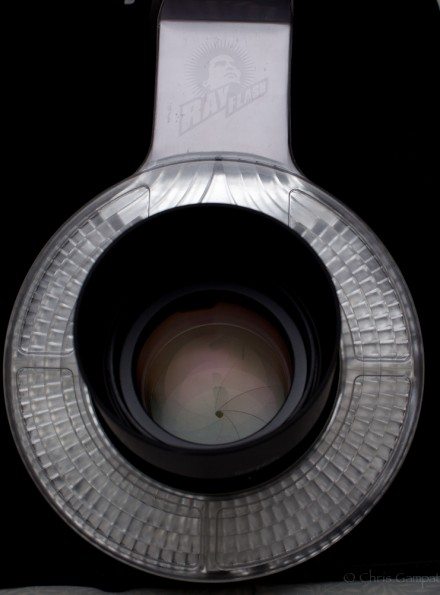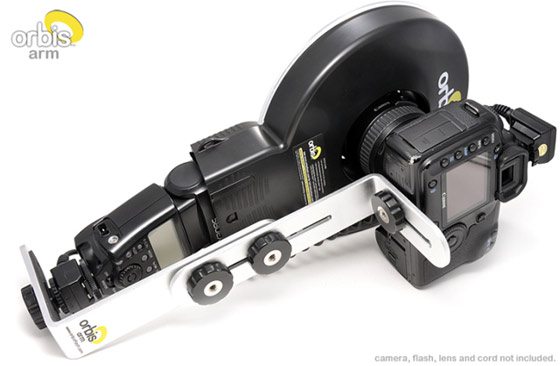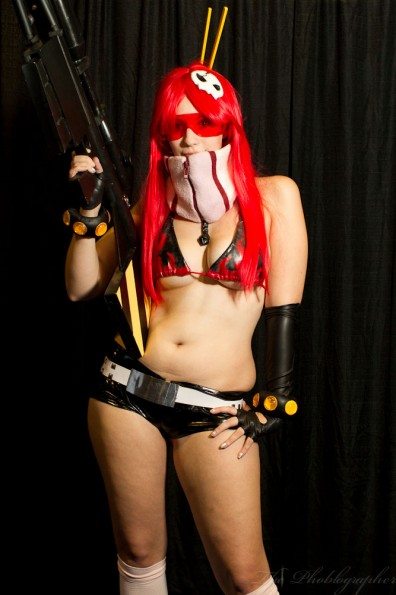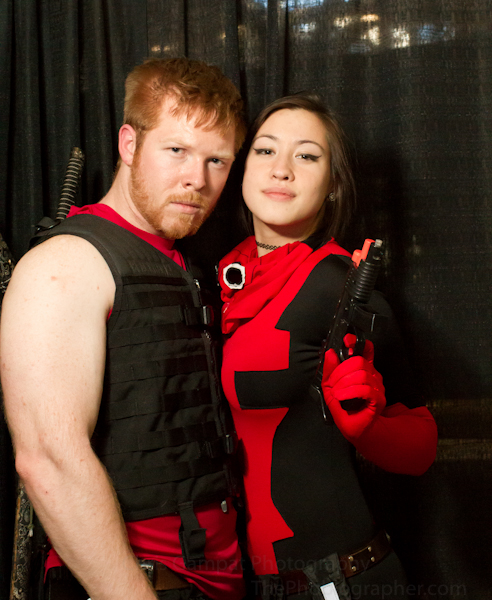Comic Con has been over with for a little while now, but if it has solidified anything that I’ve been taught it’s that your lighting is paramount. The lighting on a convention floor won’t always be ideal, and you can even take your on-camera flash’s capabilities a bit further with a light modifier. Last year, I tested the Orbis at the event and this year I took the Ray Flash—a close competitor. Though the Orbis and Ray Flash have received shining stars from us, here’s a test from us in practical use for portraits.
Gear Used:
Ergonomics
The ExpoImaging Ray Flash is a ring flash attachment that takes the light from your hot shoe flash and transfers it into a ring that goes around the lens. To use it, your flash needs to be in your hot shoe and then the Ray Flash needs to be slipped on over the flash head. ExpoImagining makes different attachments for different flashes. For example, my version will work perfectly with my 580 EX II but requires little tabs to be inserted to be held in place with my 430 EX II.
To make the best of the unit, you’ll need a long enough lens. For example, my 50mm f1.4 is very short and because of that, part of the actual ring ends up being in the frame. However, my 35mm f1.4 L holds the entire ring in place, so nothing excessive gets into the frame.
The Orbis is a different beast. It requires your flash to be out of the hot shoe and to be under the camera for a typical Ring Flash look. The attachment goes around the lens and is held in place using a bracket, or your hand. The Orbis also requires a TTL cord, wireless triggers or your camera’s infrared transmitter to be activated. For the record, if you want the hot shoe flash to “see” your on-camera flash, you’ll need to also move the Orbis around and also turn and reposition your flash.
Winner: Ray Flash for not requiring a lot more to set it up.
Durability
During my test with the Orbis last year, I ended up dropping it a couple of times because it didn’t stay on very securely. I was using it with my 430 EX II for most of the time. Luckily, the Orbis survived every time and only suffered extremely minor scratches (if any at all.) The creator, James Madelin, told me that this is because of the Ultrasonic Welding process used to create the Orbis.
When testing the Ray Flash this year, it didn’t encounter as many tortures as the Orbis did. The reason for this is because it stayed on the flash the entire time. In fact, it was a bit tough to get it off at times. The worst that could have occurred was it bouncing around Matt’s body when it was hanging on his camera since he was using the Lens Loop strap. The Ray Flash has been dropped many times on other occasions, but it has held up and still works perfectly.
I’m only afraid that one day, I may crack the insertion hole when applying too much strength to get my flash out of it. Really, the hole can be that tight.
Winner: Tie, with a slight edge to the Orbis.
Light Loss
James Madelin has told me that there is around 2 stops of light loss with the Orbis. In contrast, the Ray Flash has one stop.
In practice, I found the Orbis to work better with Canon’s E-TTL system and the results that I got when using exposure compensation were all expected when I did lighting calculations in my head.
The ExpoImaging Ray Flash didn’t work as well as the Orbis in E-TTL, and at times I found it a bit frustrating. I ended up switching the flash to 1/4 output (manual mode) and adjusting it from there. This gave me much more consistent and workable results.
Winner: Ray Flash. In the end, it will help to drain less battery power since you’ll need to often overpower your flash with the Orbis.
Portability
This is where the comparison will become very interesting:
– The Orbis, though requiring one hand to always hold the Orbis and the other to hold your camera, served a multitude of functions for me. Around the camera’s lens, it worked as an excellent ring flash. However, if I took it off and placed it camera left, it functions as an absolutely terrific soft box is that well balanced to work with almost any skin tone you can throw at me.
This therefore would have eliminated the need for many different types of light modifiers. In fact, I prefer to use it as a soft box.
– The Ray Flash seems to achieve a very specific task: it functions extremely well as a ring flash when around the lens. When off to the side though, it isn’t as great as a soft box. In fact, the output seems to mimic a snoot more. This is because of the design: the Ray Flash’s ring isn’t as broad (or large) as the Orbis’s; so by the rule of lighting, it isn’t as soft.
However, since it works best as a dedicated ring flash, I needed to have other items with me such as my Beauty Dish and the Rogue Flash Benders. That requires having an assistant to help you carry all that gear. To be fair, I had a lighting assistant holding the Orbis off to the side for me as well last year.
It should be mentioned though that a beauty dish gives off a different lighting look than a soft box does.
Winner: Tie. The Orbis is multi-purpose and the Ray Flash won’t require two hands to hold it while walking around.
Ease of Use
Both the Orbis and Ray Flash are easy to use once you get the hang of them and experiment with the light in the first place. What’s important is to remember to pay attention to your ambient light. For example, an area with lots of natural light coming in from the ceiling could allow you to drop your ISO down to 100 or 200 depending on which unit you’re using.
In general, I found the Ray Flash to be easier to use due to the more consistent output of light that I got from it. Though Canon’s E-TTL system works very well with the Orbis, I’ve just learned to not trust TTL systems in many situations because they just don’t give me the look I want.
Winner: Tie. Orbis for the person that doesn’t know the higher intricacies of lighting and the Ray Flash for the manual flash wizard.
Versatility
As stated earlier, the Orbis can function well as a soft box and Ring Flash. The Ray Flash works best as a Ring Flash.
Winner: Orbis, for the more intelligent design.
Quality of Light
This part of the review will really just be up to personal preferences.
The Orbis better compliments skin tones.
In contrast, I feel that the Ray Flash gives me more of the high end fashion style look that I’m going for.
Winner: My personal opinion is the Ray Flash for my shooting style.
Conclusion
Once again, this all comes down to personal tastes and preferences as the products are similar but different enough to justify purchasing both of them. However, I’ve always personally found that the Ray Flash is better for my needs.
But overall-
Ergonomics: Ray Flash for better and easier use.
Durability: I’ve been much tougher with the Orbis, and recommend it to many that want one item to replace a slew of others. That way you don’t have to worry about the durability of many units.
Light Loss: Ray Flash just for the stats.
Portability: it depends on the job you’re doing once again. The Orbis can fill different functions and the Ray flash is good at what it does.
Ease of Use: I personally stick with the Ray Flash more.
Versatility: Orbis
Quality of Light: This depends on your needs as well. The Orbis has a warmer output than the Ray Flash’s neutral tones.
Please Support The Phoblographer
We love to bring you guys the latest and greatest news and gear related stuff. However, we can’t keep doing that unless we have your continued support. If you would like to purchase any of the items mentioned, please do so by clicking our links first and then purchasing the items as we then get a small portion of the sale to help run the website.












